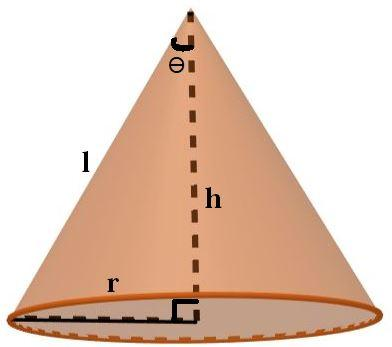Question
Question: Show that the semi-vertical angle of the cone of the maximum volume and of given slant height is \({...
Show that the semi-vertical angle of the cone of the maximum volume and of given slant height is tan−12.
Solution
To solve this problem we should have basic knowledge about trigonometry and geometry. To solve this first of all we will assume the height, slant height and radius of the cone as h, l and r respectively. Then we will express h and r in terms of l using angle θ i.e. semi-vertical angle of the cone then we will find the volume of the cone using formula V=31πr2h, and then we will take derivative of volume w.r.t angle θ and then observe where derivative changes sign to find the maxima.
Complete step by step answer:
We have to prove that the semi-vertical angle of the cone of the maximum volume and of given slant height is tan−12.
So first of all for better understanding we will draw the diagram as follows,

We have assumed height, slant height and radius as h, l and r respectively.
We know that in the figure,
sinθ=lr⇒r=lsinθ.....(1)
And,
cosθ=lh⇒h=lcosθ.....(2)
And we know that volume of a cone is given as,
V=31πr2h
Using equation 1 and 2 we get,
\Rightarrow $$$V=\dfrac{1}{3}\pi {{\left( l\sin \theta \right)}^{2}}\left( l\cos \theta \right)$
$\Rightarrow $ $V=\dfrac{1}{3}\pi {{l}^{3}}{{\sin }^{2}}\theta \cos \theta $
Now to find the maxima we will have to differentiate the above expression as,
$\dfrac{dv}{d\theta }=\dfrac{1}{3}\pi {{l}^{3}}\left( 2\sin \theta \cos \theta .\cos \theta +{{\sin }^{2}}\theta \left( -\sin \theta \right) \right)$
$\Rightarrow $ $\dfrac{dv}{d\theta }=\dfrac{1}{3}\pi {{l}^{3}}\left( 2\sin \theta {{\cos }^{2}}\theta -{{\sin }^{3}}\theta \right)$
Taking \sin \theta as common, we get
$\Rightarrow $ $\dfrac{dv}{d\theta }=\dfrac{1}{3}\pi {{l}^{3}}\sin \theta \left( 2{{\cos }^{2}}\theta -{{\sin }^{2}}\theta \right)$
We know that $\left( {{a}^{2}}-{{b}^{2}} \right)=\left( a+b \right)\left( a-b \right)$, hence we get
$\Rightarrow $ $\dfrac{dv}{d\theta }=\dfrac{1}{3}\pi {{l}^{3}}\sin \theta \left( \sqrt{2}\cos \theta -\sin \theta \right)\left( \sqrt{2}\cos \theta +\sin \theta \right)$
Dividing and multiplying by $\cos \theta $, we get
$\Rightarrow $ $\dfrac{dv}{d\theta }=\dfrac{1}{3}\pi {{l}^{3}}\sin \theta .{{\cos }^{2}}\theta \dfrac{\left( \sqrt{2}\cos \theta -\sin \theta \right)}{\cos \theta }\dfrac{\left( \sqrt{2}\cos \theta +\sin \theta \right)}{\cos \theta }$
$\Rightarrow $$$\dfrac{dv}{d\theta }=\dfrac{1}{3}\pi {{l}^{3}}\sin \theta .{{\cos }^{2}}\theta \left( \sqrt{2}-\tan \theta \right)\left( \sqrt{2}+\tan \theta \right)
Now at maxima dθdv=0, we get
\Rightarrow $$$\dfrac{1}{3}\pi {{l}^{3}}\sin \theta .{{\cos }^{2}}\theta \left( \sqrt{2}-\tan \theta \right)\left( \sqrt{2}+\tan \theta \right)=0$$
We know that {{0}^{\circ }}<\theta <{{90}^{\circ }},sointheaboveequation,\begin{aligned}
& \sin \theta =+ve \\
& \cos \theta =+ve \\
& \sqrt{2}+\tan \theta =+ve \\
\end{aligned}Asall\sin \theta ,cos\theta ,and,tan\theta arepositiveintheinterval.Butfortheterm\left( \sqrt{2}-\tan \theta \right)$, we have
